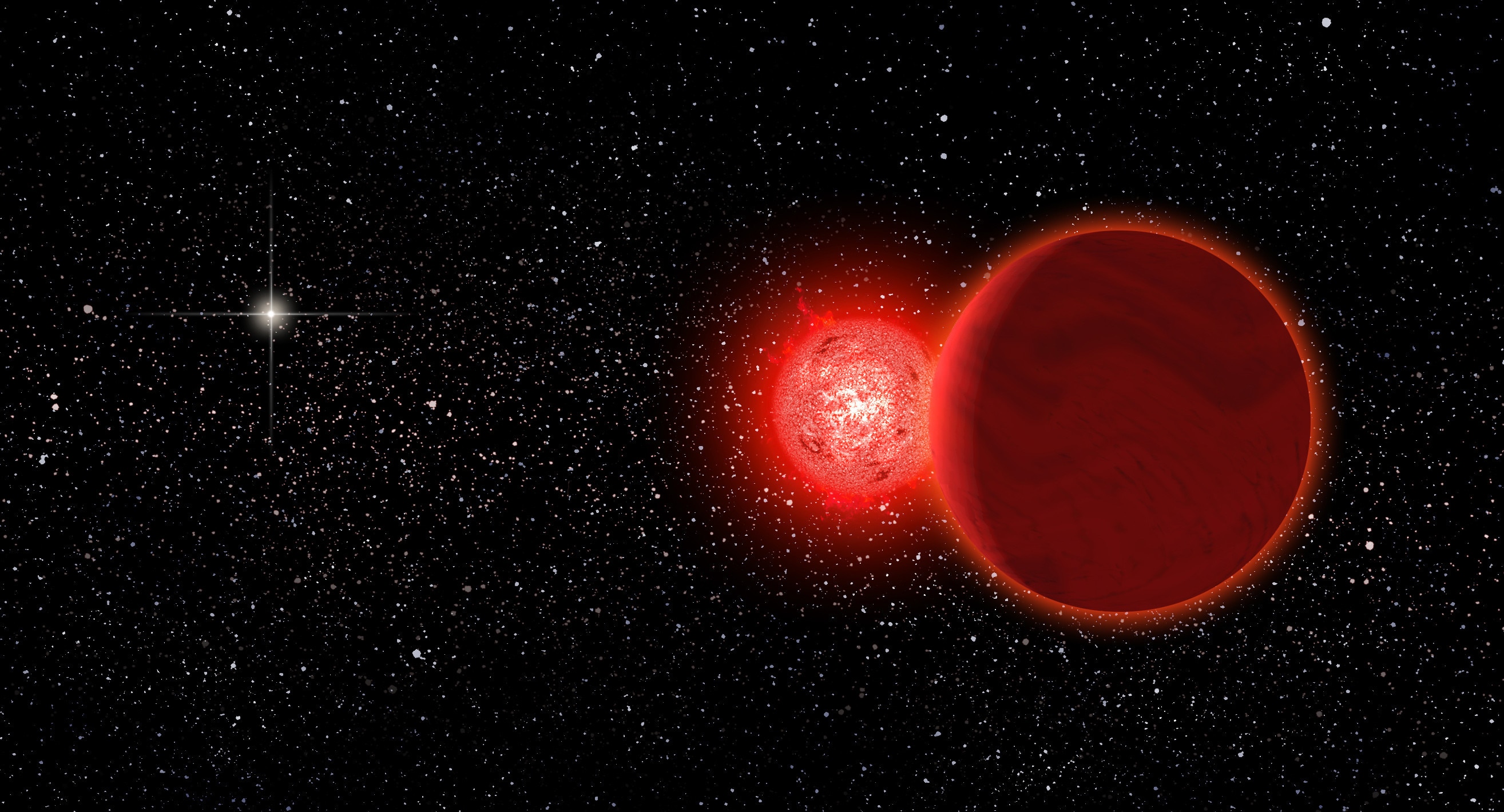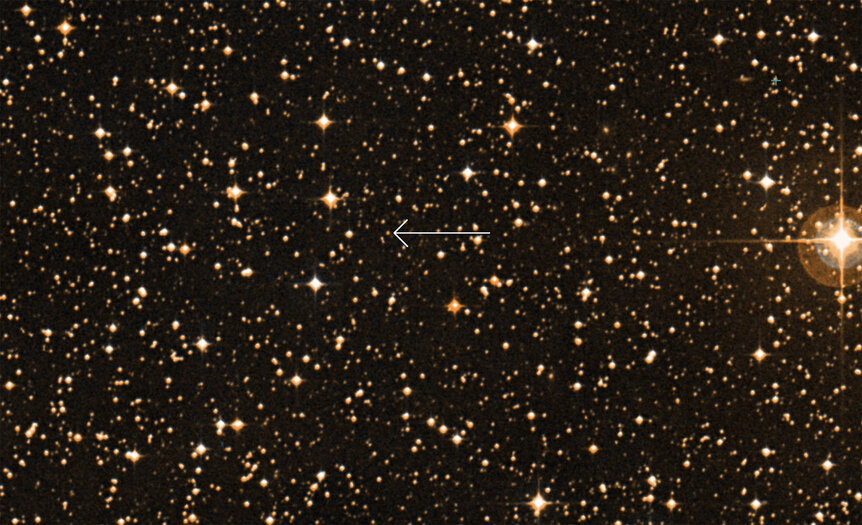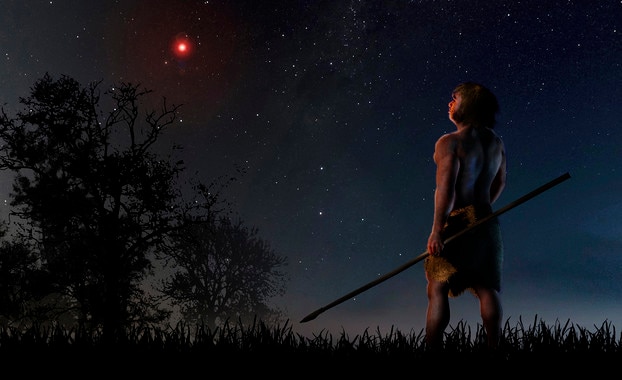Create a free profile to get unlimited access to exclusive videos, sweepstakes, and more!
Did a close pass by an alien star system millennia ago rain down comets on the solar system?

70,000 years ago, a binary star system gave our solar system a pretty close shave, passing less than a light-year from the Sun. That's unusual; on average stars are more like 4 light-years apart — in fact the closest known star to us about 4.2 light-years away.
Could this close stellar encounter millennia ago have affected the solar system in any way? The answer is…. maybe.
Gimme a sec to set this up for you.
The binary is called WISE J072003.20-084651.2 (seen by the WISE observatory and named after its coordinates on the sky), or more colloquially "Scholz's stars," since it was first identified by astronomer Ralf-Dieter Scholz. The two objects in the system are a bit odd; one is a very low-mass red dwarf star, barely a star at all (it's type M9), and the other really isn't a star but a brown dwarf, an object more massive than a planet but lacking the mass needed to ignite sustained nuclear fusion in its core (which is what makes a star a star).
The low masses of these objects make them very faint, which is why they weren't discovered until 2014. Even worse, they're located in the constellation Gemini, which is in the plane of the Milky Way, where a bazillion stars crowd together, making it harder to spot faint objects.
The binary system of Scholz's stars is about 22 light-years from the Sun… now. But tracing its motion backward in time shows that it passed very close to us 70,000 years ago. Exactly how close is hard to say, but something less than a light-year seems pretty certain.
This close pass by the binary certainly didn't affect the planets or moons in our inner solar system, but it's possible it did affect the denizens of the very outskirts of our local neighborhood: Oort cloud comets.
The Oort cloud is a roughly spherical collection of possibly trillions of iceballs out in the deep dark. Definitions vary, but it starts roughly 400 billion kilometers out from the Sun, 100 times the distance of Neptune, and may extend to more than ten trillion kilometers: About a light-year.
Which is just how close Scholz's stars passed. Hmmm. Could the binary system's gravity have affected any comets, changing their stately million-years-long orbits, and dropped them down toward the Sun?
Possibly! A team of astronomers looked at a collection of comets with unusual orbits, what we call hyperbolic orbits. Objects on these kinds of paths are moving too quickly to be bound by the Sun; as they pull away from the Sun they slow, but they're moving so rapidly the Sun's gravity can't slow them to a stop and reverse their courses. They'll leave the solar system entirely.
There are a few ways comets can become hyperbolic. One is to pass to close to Jupiter or Neptune. If they do, the gravity of these planets can give them a kick in the tail (haha! Ha! Because they're comets!), boosting their velocity just enough to become hyperbolic. We've seen this happen a few times with comets.
Another is a close pass by a star, like Scholz's binary. But how can you tell?
What the astronomers did was look at 339 hyperbolic comets to figure out the shapes of their orbits as carefully as possible, and then traced the motions of these comets backward in time about 100,000 years. This can be done using sophisticated computer models that use the physics of gravitational interactions with the planets, moons, and asteroids to see just how they affect the comets' orbits.
Because the Oort cloud is roughly spherical, you'd expect the comets would come from random directions in the sky. But that's not what they found: There were several clumps in the sky where comets seems to come from more often than other spots. Some of these you expect through random statistics, like flipping a coin and having it come up heads a few times in a row.
You can apply some math to that distribution and determine how much deviation from randomness you expect… And some of the clumps look pretty real. Including one that appears in the sky not too far from the current location of Scholz's stars.
Dun dun dunnnnnnn.
But wait! Not so fast! It's not that clear this means what you think it means. That's the location of Scholz's binary now, but 70,000 years ago, when it passed us, it was in a different part of the sky. I'd expect the comets to be coming from there, not the direction where the binary star is now.
I asked the lead author of the work, Carlos de la Fuente Marcos, about this, and he agreed. The problem is that the position of the binary star system is hard to extrapolate backward accurately, and the farther back you go the more uncertain it gets. You get what I think of as a "probability blob," a biggish area on the sky where the stars probably were, but you can't say for certain where in that area they were.
So the directions those comets came from overlaps with where the stars may have been 70,000 years ago, but it's not certain. And it's certainly not certain enough to rule out the possibility that there may be another cause for the comet clumping.
And that's why the answer to all this is "maybe." It's possible the gravity from the binary system shook up the outer solar system and sent a bunch of comets our way, but it's possible they're unrelated, too.
That's irritating. But there's a way to do better. One is to keep observing Scholz's system, get better measurements of its velocity in space, so that we can trace it backward better. Another way is to keep looking for more comets, and whenever we find one that's hyperbolic we can add it to the list and see where it falls.
Until then, this is a very interesting hypothesis, but by no means certain.
Another thing they mention that's pretty interesting: They found 8 comets out of the 339 that were moving at speeds that indicate they may be interstellar! In general, comets that start in the Oort cloud and get disturbed in some way accelerate as they fall closer to the Sun, but these were moving rapidly enough (about 1.5 kilometers per second faster than the free fall speed) that it's at least possible they came from another star. We can't say for sure, but still pretty neat.
And there's one other thing I want to add: The press release for this news came with an interesting graphic. Given the timing of the passage of Scholz's star, it happened when humans walked the Earth. In fact there were still Neanderthals along with Homo sapiens at that time! The graphic depicts an ancient person of indeterminate species gazing up at and illuminated by a red star in the sky:
There's a problem here though: Even the brighter of the two objects in the binary is so faint and weak that it would've been invisible to the naked eye! And it's not even close; it would've been about 1/100th as bright as the faintest star you can see. I know that seems counterintuitive given how close it was, but a red dwarf at that end of the mass scale is truly a dim bulb. It would have to have passed us ten times closer to be seen at all, and even then it would've been very faint (you might suppose we have that drawing wrong, and that's an alien standing on a planet orbiting the red dwarf — but that doesn't work either; the Sun would be as bright as Venus, fainter than depicted, and it's the wrong color anyhow).
It's fun to think our ancient ancestors might have seen this interstellar interloper, but in this case that had to wait a few hundred centuries for us to invent the orbiting WISE observatory. Too bad for that old H. sapiens, but look what WISE is doing for us now! It found this star in the first place. Perhaps our great-great-great-(repeat about 3,000 times)-grandparents would have been delighted to know that.

















